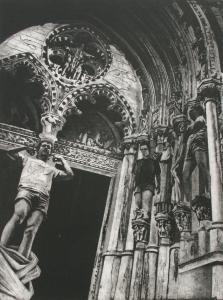Review Of Ellen Moore Osborne Art Show

February 14th, 2015 - Charlottesville, VA
Moores Intaglios: Examining Spirituality, Emptiness, And The Built Environment
Art Review-- By Kathryn Willis
Reprinted with permission from The Free Lance-Star, Fredericksburg, VA (August 16, 1993)
Works of emotional depth and subtlety await the viewer of Ellen Moore's solo exhibit, now at the Fredericksburg Center for the Creative Arts.
The subject of Moore's intaglio etchings is the relationship of people to the places where they have lived, and to the buildings and machines that they have labored to construct.
Images of men and women are from snapshots taken in the 1940s. The people who face us in these works are couples who got married and stayed married. We see them, among other places, on the front porch in the pre- air-conditioned South, sharing the simple pleasures of company and conversation.
These people are the embodiment of the Protestant work ethic. They wordlessly witness to duty and perseverance. But in their faces, there is also a hint of resignation; the pressures of daily life have taken precedence over their personal dreams.
The world they inhabit takes them from screen-doored kitchens to massive factories and welded steel overpasses- structures into which their life work, and dreams, are invested.
The energy of their labors in constructing these structures recalls the optimism and pride of post-World War II America. Steel and concrete would somehow offer us all answers. But in these prints, industry and machines overpower and dwarf the people who made them.
Moore’s depictions tentatively explore the spirituality of these people, implicitly asking, "Where do they place their faith, their hope?" Ellen Moore does not fear the question.
Several works combine images of Gothic architecture with those of simple wooden churches of the rural South. The faith passed to America through centuries of rich development now seems empty. The wooden churches, left untended for decades, are now in near ruin. The intricate and elaborate design of medieval cathedrals, as well as their imposing scale, are now reflected in wires, pipes and industrial precision.
And what of our own time? In "Deafened by the Divine," two young men stand in place of the statues of saints at the doors of a cathedral. Casual in posture, they stare down, one with fingers placed in both ears, either incapable or defiant in their hearing.
In counterpoint, "Ark of Safety" depicts the interior of a primitive, non-denominational church, which invites worshipers with a large, handwritten poster. The sign announces: "Ark of Safety Revival Center. All ministers invited. Male and female. All color. Denomination. One Heaven One Hell." Just above the church, in a space that can be read as the background, there is a broad river into which cows have waded to find relief from the summer’s heat.
The simple and sincere appeal of the church’s sign finds an echo in this bucolic river scene. The cows become a metaphor for the universal longing for unity, for simplicity, for a cooling balm from life. Their harmony in black and white, seeking relief in the river, arches over the entire work like a reassuring rainbow.
One of the strengths of Moore’s works is her courage to deal directly with these spiritual elements, both for their poignant appeal and to examine their seeming rejection by our current culture. But her tone is nonaccusatory. Instead, she is a sensitive observer, inviting open-ended contemplation about the issue.
Here, spirituality appears absent in the young, overwhelmed by massive industry, and altogether abandoned in the buildings constructed by organized religion. Yet the people who inhabit Moore’s world are not devoid of a spiritual quality. Instead these slightly pudgy men (khaki shirts tucked in and leather work boots sturdily laced), and shrug-shouldered women (dresses neatly tailored, wearing round-toed heels and small pearl necklaces) are neither tragically noble nor pitiably manipulated.
In short, they are human. But their eyes speak to us of the dignity that comes from leading an essentially moral life. And of the character built by living for the long haul and not for the quick rush.
Moore suggests that the spirituality lies in the people themselves, and not in the religious institution nor in the machines that they have labored so hard to build.
These works achieve a dreamlike quality from their subtle shadings and delicate textures. Moore has employed soft ground, aquatint, and other techniques to accomplish this subtlety. The result of her meticulous composition is like viewing a distanced childhood through the lens of emotion and insight.
Particularly appealing are the intaglio etchings "In Remembrance of the Porch Photos," "Daddy Could’ve Been a Sailor," and "Pepsi Cola and Moon Pie."
Moore’s intaglios achieve their strength from stating quiet truths about these people and times, inviting our reflection. The result is a kind of distilled visual poetry.

